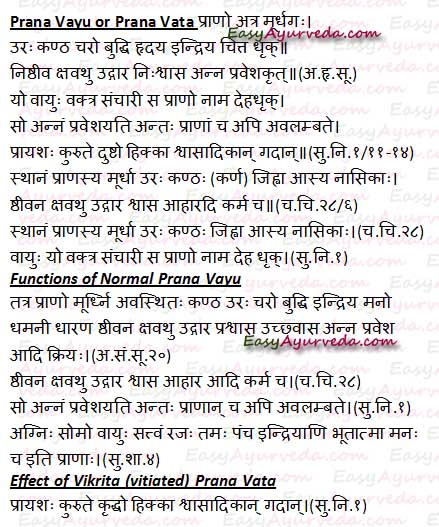Prana Vayu (Pranavata) Location, Functions, Symptoms of vitiation
Article by Dr Raghuram, MD (Ay) and Dr Manasa, BAMS
Among the 5 subtypes of Vayu, Prana Vayu is the most important one. Chief site of Prana Vata is head. It circulates through the throat, mouth, sense organs and chest, encompassing the vital organs and structures located in these areas.
Table of Contents
Site of Prana Vayu
The chief site of Prana Vayu is Murdha or head. The Prana Vayu operates its activities being located in shira or murdha. Thus the chief site of Prana Vata can be correlated to the brain and sense organs located in the head.
Areas of circulation
Areas of circulation of Prana Vayu
The areas of circulation of Prana Vayu are:
- Uraha – chest (thorax), includes chest organs heart and lungs
- Kanta – Throat, trachea or neck
- Karna – Ear
- Jihva – Tongue
- Asya / Vaktra – Mouth or oral cavity
- Nasika – Nose
Being located in the head, it keeps circulating through the throat, mouth, sense organs and chest, encompassing the vital organs and structures located in these areas.
Read related: Sub Types Of Vata Dosha: Importance, Salient Features

Features
Special feature (predominant function) of Prana Vayu
According to Sushruta (Su.Su.15/4), Purana is the lakshana of Prana Vayu. Acharya Dalhana, commentator of Sushruta Samhita explains Purana as ‘Pooranam aahaarena, Pranasya Karma’ which means ‘to fill the body with the food’. In other treatises it is mentioned as ‘Anna Praveshakrit’ i.e. helps in intake of food and makes its entry into thes stomach easy.
Functions
Functions of Normal Prana Vayu
Buddhi Hridya Indriya Chitta Drik – Prana Vayu is primarily located in the head or brain. It is bound to control the functions of the brain or nerves, or it could be put in other way and said that the brain and nerve functions can be compared to those of Prana Vayu. Vagbhata in Ashtanga Hridaya also tells that Prana Vayu commands Buddhi (intellect), Hridaya (mind, in this context), Indriya (sense organs and their functions) and Chitta (brain). This shows that the higher functions including perception of sense objects, the motor signals in response to the sensory signals, the thought processes, the intelligence and application of intelligence so as to lead the day to day activities, integration of mind and sense organs, and all mind functions are manipulated, controlled and governed by Prana Vata.
Anna pravesha / Aharadi karma – helps in pushing the food down into the food pipe into the stomach, i.e. process of deglutition. We keep the food in the mouth and are not conscious that we are chewing or swallowing it. These activities are carried out without our knowledge. Take for example an insane person, if food is fed to him, he may not swallow it in spite of giving commands or demonstrating the same. His food passages may be fine but there is no command or control from Prana Vayu which carries on the next function of pushing the food down. As a result, the insane person can either keep the food in the mouth without swallowing it, or throw it out or vomit if the food happens to descend downwards. This control and command mechanism to swallow and hold food in the gut may be lost in case of failure of Prana Vayu.
Nisteeva – helps in the process of salivation. This function of Prana Vayu probably helps in identifying the taste of food and appreciating it, the preliminary digestion takes place with the help of proper salivation process wherein the food is mixed with saliva and lubricated, thus making it easy to swallow.
Kshavathu – Prana Vayu is responsible for sneeze. Sneeze is an important reflex to clear out the nasal passages of dust, microbes, allergens and impurities. It is a protective mechanism which guards the respiratory passages. This also means that Prana Vayu circulating in the nasal passages identifies the unwanted entries and flushes them out. Prana Vayu can thus be provoked by dust, fumes etc.
Udgaara – Prana Vayu is responsible for eructation (belching). We get eructation when our stomach fills with food or when it is about to be filled. Again, as already said, the entry of food into stomach is also controlled by Prana Vata. Pure belching is the sign of good digestion. Here, we don’t notice any odd taste in the eructation. Belching can be normal or abnormal. Abnormal belching or eructation takes place in presence of improper digestion and when semi-digested food is left out in the stomach, or when the stomach contents are not cleared into the intestine or when there is delayed digestion. This part is monitored by disturbed samana vayu and pachaka pitta (pitta subtype) located in the stomach and also due to improper coordination between Prana and Samana Vayu.
Nishwasa (Prashwasa Uchchwasadi Kriyaha – A.S.Su.20) – Prana Vayu carries out smooth breathing functions and movements. Prana Vayu on circulating in the chest makes breathing process easy by creating space for inspiration and expiration by creating movement of organs of breathing (lungs and heart) and movements of main and accessory muscles of respiration. Prana Vayu thus creates expansion and contraction of chest cavity so as to enable free breathing and good aeration in the body. Mainly it helps in breathing in (inspiration) of air or oxygen.
Dhamani Dharana (A.S.Su.20) – Prana Vayu controls the functions of the dhamanis. In this context dhamani shall be considered as nerves. The nerve conductivity of signals to and from the brain is under the control of Prana Vayu.
Praanaan cha Avalambate (Su.Ni.1) – By making the external air needed for life activities to enter into the body and filling (saturating the body and cells) the entire body with air (and nutrition from food) will support and nurture the body, body functions and the 13 types of Pranas.
The 13 types of Prana supported by Prana Vayu are – Agni (fire or pitta), Soma (moon or kapha), Vayu (air), Sattva, Raja, Tama, Shrotra (ear or sense organ of sound), Twak (skin, sense organ of touch), Netra (eyes, sense organ of sight or vision), Jihwa (tongue, sense organ of taste), Ghrana (nose, sense organ of smell), Bhutatma (minor representative of the greater soul) and Mana (mind).
Satva, Raja and Tama are the qualities of the mind.
To sum up –
The description of Prana Vayu and its functions shows that this subtype of Vayu has two platforms of functions.
Higher Functions of Prana Vayu – Prana Vata while functioning in the Murdha (head or brain) performs higher functions like Buddhi Dharana, Hridaya Dharana, Indriya Dharana and Chitta Dharana.
Lower Functions of Prana Vayu – While Prana Vata is in circulation down through trachea, salivary glands, pharynx, stomach, heart and lungs, it renders lower functions like Nesteeva, Kshavathu, Udgaara, Nishwasa and Anna Pravesha.
Vikrita Prana Vata
Effect of Vikrita (vitiated) Prana Vata
When the Prana Vayu gets vitiated it causes diseases like Hikka (hiccough), Shwasa (dyspnoea, breathlessness, asthma, and bronchitis), Pratishyaya (cold, congestion), Swarabheda (hoarseness of voice), Kasa (cough) etc. By this it clearly looks like the pathological manifestations and the territory afflicted by the vitiated Prana Vayu is predominantly the respiratory system.
How to balance Prana?
How to control / treat / balance Prana Vayu?
Dr JV Hebbar
At the first hearing, this looks like a legitimate question. But it cannot have a definitive answer. As per Ayurveda Prana Vayu is one among 5 types of Vata Dosha. Each Dosha is divided into 5 types based on location and functions.
A single sub type of Dosha rarely goes out of balance alone to cause a disease. Usually a disease is often caused by a mix of many doshas, local channels, tissues, waste products, digestive fires etc.
Ayurveda explains the areas of Prana Vayu dominance as –
Uraha – chest (thorax), includes chest organs heart and lungs
Kanta – Throat, trachea or neck
Karna – Ear
Jihva – Tongue
Asya / Vaktra – Mouth or oral cavity
Nasika – Nose
Prana Vayu functions in the body are – spitting out, sneezing, burping / belching, downward peristalsis movement of food from the esophagus to stomach and from there to intestine and breathing.
So, Prana vayu imbalance in the chest will produce a different set of symptoms compared to its imbalance in the digestive tract. So, there is nothing like “only Prana Vata” got imbalanced to cause a disease affecting all the above mentioned organs, all at once.
Similarly, there is no fixed formula to balance the Pranavata and thus magically cure all diseases related to chest, throat, ear, oral cavity etc.
Read: Samprapti Ghatakas – Components Of Manifestation Of Disease
Examples of doshas conspiring with other elements like tissues, waste products etc. to cause a disease:
Ama – a product of altered digestion and metabolism, disturbs Pachaka Pitta and digestive fire in the stomach, with the help of Vata Dosha, drags the digestive fire out. It circulates allover the body through the channels of nutrition (Rasavaha channels) to cause jwara – fever.
Here, balancing just one dosha will not solve the problem.
Read: Pathology of fever as per text: Madhava Nidana
Another example: The vitiated Prana Vata associated with Udana Vata produces sounds resembling that produced by a broken piece of bronze when struck. These doshas also expel sputum and other morbidities through the mouth. This is called Kasa – cough.
Read: Kasa (Cough): Causes, Pathogenesis, Types, Treatment
To treat it, Prana vata, along with Udana vata should be balanced and restored to move in normal direction along with balancing Kapha dosha and soothing of respiratory tracts.
Bottom line is – diseases are not caused just by an increase of one particular dosha. Often a disease is caused due to multiple factors going out of balance, including doshas, tissues, channels, digestive fire, mental factors, vital points, organs etc.
Read related: Breaking Of Disease Pathogenesis: Meaning, Importance (Samprapti Vighatana)









